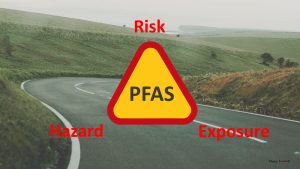By Lars Brunken
Many per-and polyfluoroalkyl substances (PFAS) are highly stable and mobile, which allows them to distribute widely in humans and the environment and to stay there for a long time. We are all exposed to PFAS through our environment, the food we eat and the water we drink. While this in itself is reason for concern, it is important to find out how and to what extent PFAS exposure may affect our health.
In chemical risk assessment, many factors must be considered. The general concept of Risk as a function of Hazard and Exposure is a good starting point. A Hazard is the property of a chemical to cause harm and the process of hazard identification answers to the question: what type of health effects can be caused by a chemical or chemical mixture? The next step is to characterize the relationship between dose and response, and finally, we need to understand how we encounter the chemicals, in other words, how- and to which doses of the chemicals we are exposed.
In my project I am combining hazard identification and dose-response modelling with exposure data to assess risks to human health. I am analyzing data from people with high PFAS blood levels using computational modelling tools to investigate the dose-response relationships between PFAS exposure and health-related effects and their biomarkers.
The following steps are planned:
1.Evaluate and customize tools for dose-response analysis using available toxicological and epidemiological data for PFAS.
2.Find and characterize links between exposure and biomarkers relevant for disease in human samples.
3.Combine results with findings from other parts of the PERFORCE3 network to explain mechanisms behind the observed effects.
Improvements are needed for approaches and tools that form the basis for PFAS risk assessment to ensure a safer environment for generations to come; this is our mission!
About the Author
Lars Brunken is a PERFORCE3 Early Stage Researcher working at the Karolinska Institutet, Sweden. His research focuses on Dose-response assessment of PFAS mixtures in relation to biomarkers of effects relevant for cardiovascular disease in humans. He can be reached on twitter (@BrunkenLars) or by email (lars.brunken.2(at)ki.se).




